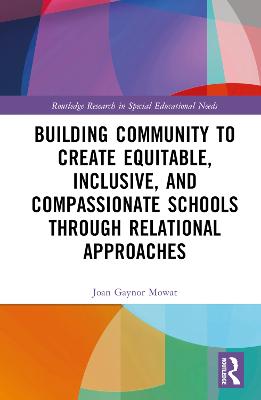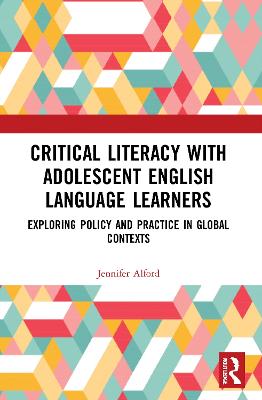Building Community to Create Equitable, Inclusive and Compassionate Schools through Relational Approaches
 -10%
portes grátis
-10%
portes grátis
Building Community to Create Equitable, Inclusive and Compassionate Schools through Relational Approaches
Mowat, Joan G
Taylor & Francis Ltd
11/2022
290
Dura
Inglês
9781138607606
15 a 20 dias
453
Descrição não disponível.
Introduction: Making a Difference to the Lives of Children and Young People
Part I: Understanding the Drivers for Change within the System: The Policy Context
Chapter 1 Understanding the Policy Context: The Macrosytem
Chapter 2 Inclusive Education: Challenges, Tensions and Dilemmas
Part II: Exploring and Understanding the Problem
Chapter 3 Marginalisation, Social Exclusion and the Impact of Poverty on Children and Young People
Chapter 4 Schools as Places of Belonging or Exclusion: School Disaffection
Chapter 5 Understanding Social, Emotional and Behavioural Needs (SEBN)/Mental Health Needs (SEMHN)
Chapter 6 Looking through the Lens of Developmental Theory to Understand Social, Emotional and Behavioural Needs (SEBN)/Mental Health Needs (SEMHN)
Part III: Towards New Understandings: Challenging Orthodoxies and Building Community through Relational Approaches
Chapter 7 Challenging the Orthodoxies of Behaviour Management through an Examination of Power, Influence and Authority
Chapter 8 Challenging the Orthodoxies of Behaviour Management through a Focus on Policy and Practice
Chapter 9 Building Community through Nurture and Trauma-Informed Practice
Chapter 10 Building Community through Restorative Justice/Practice
Part IV: Empowering the School Community
Chapter 11 Working Collaboratively Together to Empower the School Community through Pupil Participation and Parental Engagement
Chapter 12 Empowering the School Community through Socially Just and Culturally Responsive Leadership
Part I: Understanding the Drivers for Change within the System: The Policy Context
Chapter 1 Understanding the Policy Context: The Macrosytem
Chapter 2 Inclusive Education: Challenges, Tensions and Dilemmas
Part II: Exploring and Understanding the Problem
Chapter 3 Marginalisation, Social Exclusion and the Impact of Poverty on Children and Young People
Chapter 4 Schools as Places of Belonging or Exclusion: School Disaffection
Chapter 5 Understanding Social, Emotional and Behavioural Needs (SEBN)/Mental Health Needs (SEMHN)
Chapter 6 Looking through the Lens of Developmental Theory to Understand Social, Emotional and Behavioural Needs (SEBN)/Mental Health Needs (SEMHN)
Part III: Towards New Understandings: Challenging Orthodoxies and Building Community through Relational Approaches
Chapter 7 Challenging the Orthodoxies of Behaviour Management through an Examination of Power, Influence and Authority
Chapter 8 Challenging the Orthodoxies of Behaviour Management through a Focus on Policy and Practice
Chapter 9 Building Community through Nurture and Trauma-Informed Practice
Chapter 10 Building Community through Restorative Justice/Practice
Part IV: Empowering the School Community
Chapter 11 Working Collaboratively Together to Empower the School Community through Pupil Participation and Parental Engagement
Chapter 12 Empowering the School Community through Socially Just and Culturally Responsive Leadership
Este título pertence ao(s) assunto(s) indicados(s). Para ver outros títulos clique no assunto desejado.
Social Justice;Equity;Children's Rights;Inclusion;Marginalisation;Children's Mental Health and Wellbeing;Emotional and Behavioural Difficulties;School Climate and Discipline;Behaviour Management;School Culture and Leadership;Compassionate Schools;USA;Follow;Scottish Government;Scottish Policy Context;Education Systems;ADHD;Attention Deficit Hyperactivity Disorder;GIRFEC;School Discipline;Nurture Group;School Disaffection;Secretary Of State;Collaborative School Cultures;Positive School Ethos;Unconditional Positive Regard;Coordinated Support Plan;Disengage;Restorative Justice;Parental Engagement;TESS;School Discipline Policies;Vice Versa;Assertive Discipline;Adverse Childhood Experiences
Introduction: Making a Difference to the Lives of Children and Young People
Part I: Understanding the Drivers for Change within the System: The Policy Context
Chapter 1 Understanding the Policy Context: The Macrosytem
Chapter 2 Inclusive Education: Challenges, Tensions and Dilemmas
Part II: Exploring and Understanding the Problem
Chapter 3 Marginalisation, Social Exclusion and the Impact of Poverty on Children and Young People
Chapter 4 Schools as Places of Belonging or Exclusion: School Disaffection
Chapter 5 Understanding Social, Emotional and Behavioural Needs (SEBN)/Mental Health Needs (SEMHN)
Chapter 6 Looking through the Lens of Developmental Theory to Understand Social, Emotional and Behavioural Needs (SEBN)/Mental Health Needs (SEMHN)
Part III: Towards New Understandings: Challenging Orthodoxies and Building Community through Relational Approaches
Chapter 7 Challenging the Orthodoxies of Behaviour Management through an Examination of Power, Influence and Authority
Chapter 8 Challenging the Orthodoxies of Behaviour Management through a Focus on Policy and Practice
Chapter 9 Building Community through Nurture and Trauma-Informed Practice
Chapter 10 Building Community through Restorative Justice/Practice
Part IV: Empowering the School Community
Chapter 11 Working Collaboratively Together to Empower the School Community through Pupil Participation and Parental Engagement
Chapter 12 Empowering the School Community through Socially Just and Culturally Responsive Leadership
Part I: Understanding the Drivers for Change within the System: The Policy Context
Chapter 1 Understanding the Policy Context: The Macrosytem
Chapter 2 Inclusive Education: Challenges, Tensions and Dilemmas
Part II: Exploring and Understanding the Problem
Chapter 3 Marginalisation, Social Exclusion and the Impact of Poverty on Children and Young People
Chapter 4 Schools as Places of Belonging or Exclusion: School Disaffection
Chapter 5 Understanding Social, Emotional and Behavioural Needs (SEBN)/Mental Health Needs (SEMHN)
Chapter 6 Looking through the Lens of Developmental Theory to Understand Social, Emotional and Behavioural Needs (SEBN)/Mental Health Needs (SEMHN)
Part III: Towards New Understandings: Challenging Orthodoxies and Building Community through Relational Approaches
Chapter 7 Challenging the Orthodoxies of Behaviour Management through an Examination of Power, Influence and Authority
Chapter 8 Challenging the Orthodoxies of Behaviour Management through a Focus on Policy and Practice
Chapter 9 Building Community through Nurture and Trauma-Informed Practice
Chapter 10 Building Community through Restorative Justice/Practice
Part IV: Empowering the School Community
Chapter 11 Working Collaboratively Together to Empower the School Community through Pupil Participation and Parental Engagement
Chapter 12 Empowering the School Community through Socially Just and Culturally Responsive Leadership
Este título pertence ao(s) assunto(s) indicados(s). Para ver outros títulos clique no assunto desejado.
Social Justice;Equity;Children's Rights;Inclusion;Marginalisation;Children's Mental Health and Wellbeing;Emotional and Behavioural Difficulties;School Climate and Discipline;Behaviour Management;School Culture and Leadership;Compassionate Schools;USA;Follow;Scottish Government;Scottish Policy Context;Education Systems;ADHD;Attention Deficit Hyperactivity Disorder;GIRFEC;School Discipline;Nurture Group;School Disaffection;Secretary Of State;Collaborative School Cultures;Positive School Ethos;Unconditional Positive Regard;Coordinated Support Plan;Disengage;Restorative Justice;Parental Engagement;TESS;School Discipline Policies;Vice Versa;Assertive Discipline;Adverse Childhood Experiences







